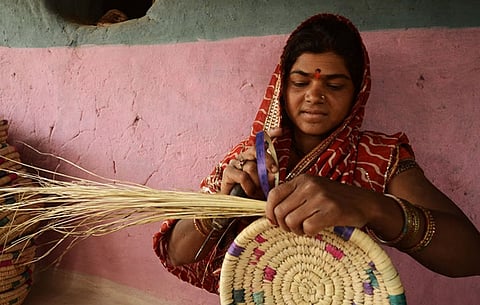
- Destinations
- Experiences
- Stay
- What's new
- Celebrating People
- Responsible Tourism
- CampaignsCampaigns
- Subscribe
- Buy Now

Among India’s numerous craft traditions is the art of basket weaving. Originally pioneered by women from rural India, the baskets are made of materials like wood and grass to serve as food containers, collectables or for purely aesthetic purposes. The craft of basket weaving has a foothold all along the length and breadth of the country, from the kiltas of Himachal Pradesh and the kauna of Manipur to the Chettinad kottan of Tamil Nadu and the cane and bamboo basketry of Goa.
But have you heard about the little-known Ranidongri basket weaving tradition of Madhya Pradesh? This small sleepy town is known for its beautiful and artistic baskets or tokris, as they are called. What makes them unique are their distinctive patterns, which are woven in during the making of the basket. Here’s all you need to know about the Ranidogri basket weaving tradition.
The women of Ranidongri and Amla villages—which is where the craft is centred—weave their baskets using the most ubiquitous plants found in the area: dog rose, honeysuckle and blackberry briars. Grass and rushes are also used in making the baskets, which are primarily used for storing raw and cooked food.
So, how is it made? A basket requires a base, side walls and a rim. Depending on the cultural practice of the area, it can also have a lid, handle or other embellishments. By changing the size, colour or placement of a certain style of weave, a wide variety of patterns can be made. In Ranidongri basket weaving, achieving a multi-coloured effect requires dying the twine first and then weaving a bunch of them together in elaborate patterns.
The lifespan of the finished baskets is about one-and-a-half to two years. Many are sold in local and faraway markets, making them prized finds for people who appreciate local craftsmanship. A unique quality of Ranidongri baskets is their ability to keep stored items cool and ventilated. The circular form and aesthetics of the basket are also unique to the Ranidongri area.
The beautiful baskets of Ranidongri have put a small town on the radar of people who enjoy quality craftsmanship and support indigenous heritage. However, the particular kind of grass used to make the baskets is difficult to obtain. Craftspeople frequently have to walk almost 10-12 km to collect the reeds. Thus, the hindrance to harvesting the grass has led to the decline of the tradition.
If you’re in the area, show your support for the Ranidongri basket weaving tradition by buying them directly from the locals. Spot how the baskets come in different shapes and sizes; they can also be customised to suit your needs.
